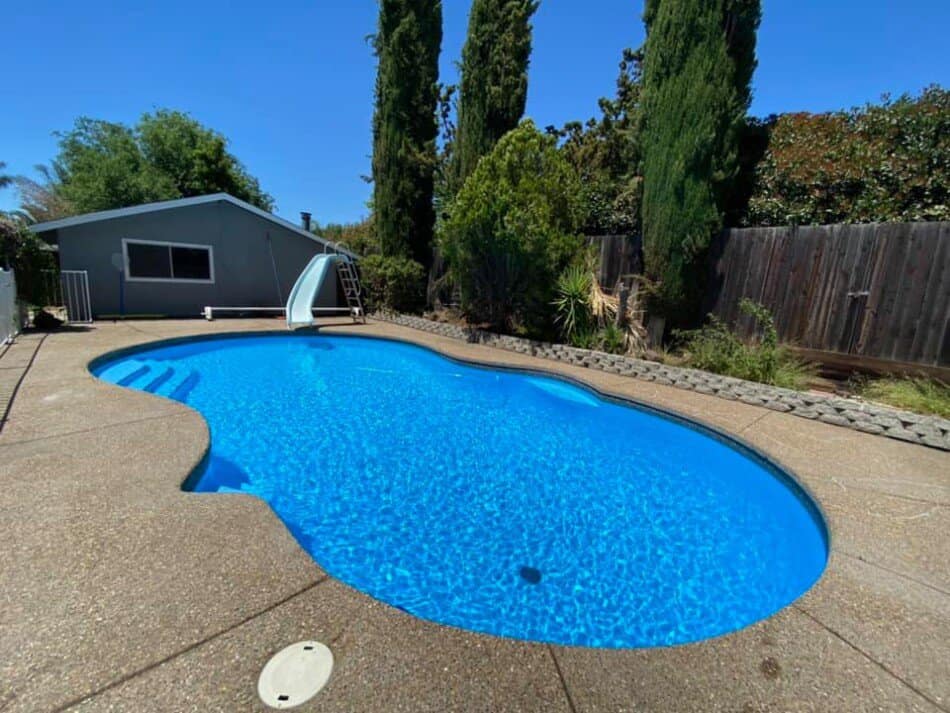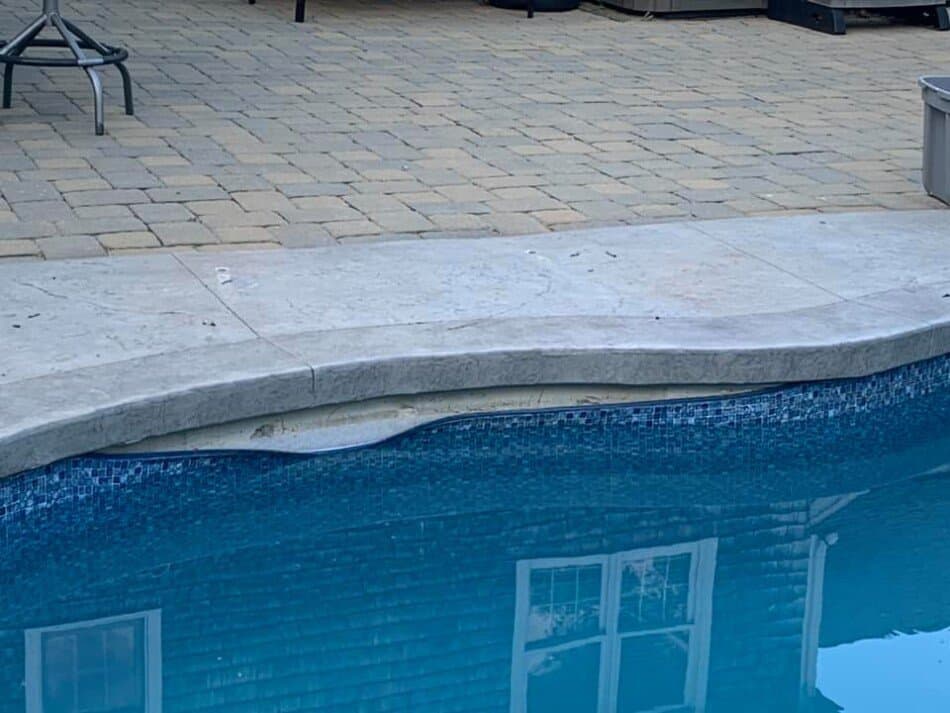A vinyl pool can be absolutely great when everything is performing well. But, a complete nightmare if the liner gets torn or is even installed poorly. This can lead some to throw up their hands and look for an alternative, especially if you bought a home with a pool that you weren’t so thrilled about maintaining.
There are several options available for refinishing and replacing the interior of a concrete pool with a vinyl liner. These options include epoxy paint, chlorinated rubber paint, acrylic paint, pool tiles, Pebble Tech, and Quartzscape finish. It is important to note that these options are only suitable for pools with concrete shells and cannot be used on pools constructed with vinyl liner pool kits. While paint options may be less expensive, they may not provide the same level of quality as the other finishes.
I’ll discuss the options below to see which one is right for you!
Why Your Concrete Pool Needs a Liner?
This is a simple but great question to answer before we get into the options for replacing the vinyl liner in your pool. The reason you need a vinyl liner is that concrete is permeable and allows liquids to pass through it. If your pool did not have the vinyl liner inside or any other type of finish your pool would slowly but surely allow the pool water to pass through it into your groundwater. Which would then cause a heap of other issues for you and cost a ton of money in the long run.
In most cases, before the vinyl liner was placed on the interior of your pool shell, there was a plaster finish. This plaster is far less permeable than concrete and can actually be the only finish on your pool if you desired as I’ll discuss below.
Choosing Paint to Replace your Vinyl Liner
Paint can be a great alternative for pool owners looking to replace their vinyl liner. There are even some options that can be DIY if you would like to jump in and save the cost of having it done for you.
Epoxy Paint as a Vinyl Liner Alternative
70% of concrete pools that have a paint finish use Epoxy paint. It’s a great option because of its chemical resistance, stain resistance, and waterproofing attributes. A disadvantage to Epoxy paint finish is that it is not the easiest paint to choose for a DIY project and probably best to hire professionals to handle it. If you would like to purchase your own, In the Swim is a respected brand and you can find their paint here. One gallon of epoxy will cover between 100-125 square feet. Olympic Epoxy pool paint is also a highly respected option among DIY Professionals.
When using Expoxy, you can expect 2-3 years lifespan before you will need to add a fresh coat of paint on top. This is if their original application of the paint is done correctly.

Chlorinated-Rubber Paint
To the eye, Chlorinated-rubber and epoxy paint look exactly the same. You would need to run a test to determine which one is which actually. The reason I’m letting you know about this is that these two paints are not compatible. If for example, you use chlorinated-rubber paint, years later you would not be able to apply epoxy paint without sandblasting the chlorinated rubber off of the pool interior first.
Why choose rubber paint over epoxy?
The simple reason for the price, you can see here, In the Swim sells chlorinated rubber paint that is much cheaper than their epoxy paint per gallon. The application of this paint, just like epoxy, isn’t easy, the smell after the application is extremely strong, and the paint itself will not last as long as epoxy. Personally, I believe epoxy would be the best option to go if you are going to paint. Chlorinated rubber will also fade and discolor over time.
Acrylic Paint is the cheapest alternative to your Vinyl Liner
Obviously, as the cheapest option Acrylic paint will need to be reapplied more often, most likely after every season. Unlike the other paints though, Acrylic will only need to be power washed off of your pool in the future and you won’t need to sandblast it if you want to use something different in the future. And, if you spend a lot of time on your home and repainting your pool every season isn’t an issue for you, then this option should not be overlooked. Insl-x has a great product but the price isn’t as cheap as other options out there.
If you go the DIY route, be sure to get yourself an excellent paint roller cover like pro-grade, you do not want to see lint all over the sides of your pool walls after all of that effort painting.
Plaster as an alternative to your Vinyl Liner
More likely than not, underneath your vinyl liner on top of the concrete shell is already ½-¾ of an inch of plaster on the concrete. If you don’t know the exact history of your pool and wonder why the previous owners chose to put a vinyl liner over the plaster, the reason would cost. A new vinyl liner might be $5,000 thousand are more depending on the size of the pool, while replastering a pool can cost $10,000-$30,000 depending on your location and size of your pool. Replastering your pool will look better than paint ever will and can last up to 12-15 years if maintained properly.

Pebble-Tech is Long-Lasting But Not Cheap
This is top of the line finish for any concrete pool. Thus making it by far the most labor-intensive and expensive option out there. Depending on the size of your pool and location but we can estimate that perhaps a 1000 sq. ft. pool of 12,000 gallons could cost in the ballpark of $14,000-$16,000 dollars to finish with pebble tech. Depending on the contractor this may or may not include pool tile along the pool line. Which is more expensive, which I’ll get into in the next section. If you are looking for a replacement for your vinyl liner, I think this is probably the least economical option available and I don’t think many homeowners would choose this unless they are having a custom pool built with their own design.
Pool Tile
This is the last option and the most expensive option. Most pools only use pool tile along the water line because it is so stain resistant and just looks gorgeous when paired with pebble tech. You don’t see many pools that are completely done in pool tile unless they are commercial projects for a 5-star hotel or resort. I don’t think this is a feasible option for anyone looking to replace their vinyl liner pool but it is an option so I thought I would list it.
What option should you choose to replace your vinyl liner pool?
Well, you could always just choose a different liner which may not be the cheapest option but probably the least labor-intensive and will last quite a while in comparison to painting. Economically though, if you need to get something done but are on a super tight budget, consider hiring someone to paint your pool with epoxy paint or take up doing the DIY route with Acrylic paint. If you hire someone to paint, prices might range from $0.15 – $0.30 per gallon of your total pool capacity. A 30,000-gallon pool may cost $4,500. Perhaps, hiring a professional to help with your first application of the epoxy paint and then adding new coats in the future yourself might be smart and economical.

